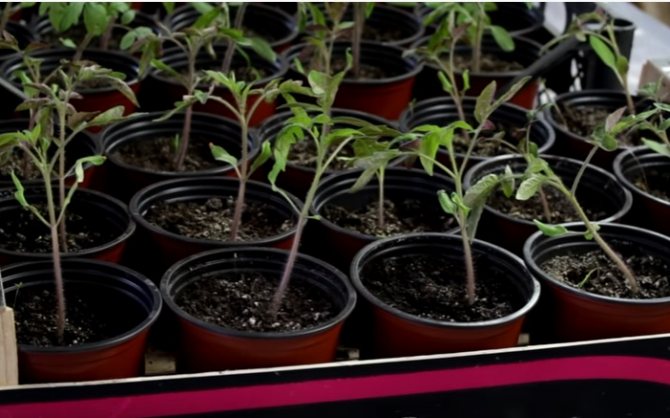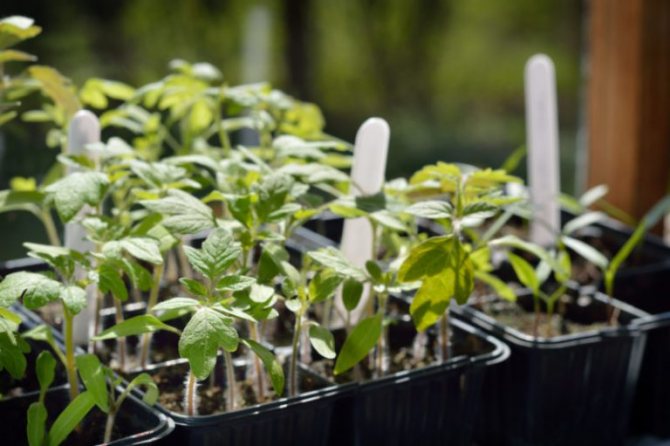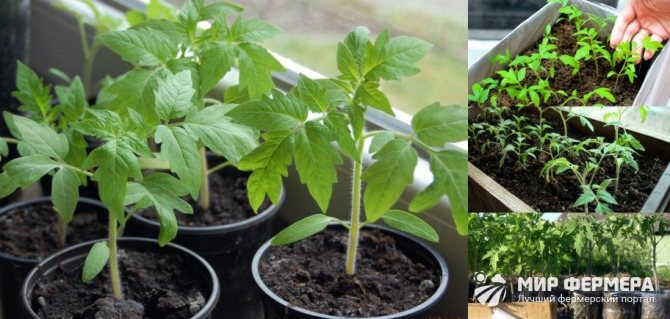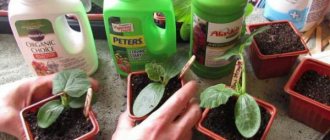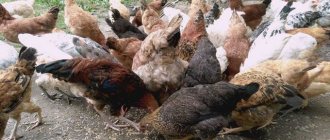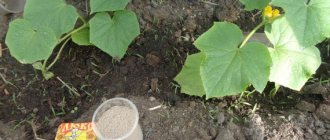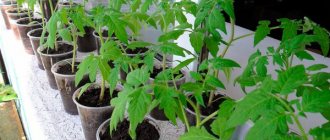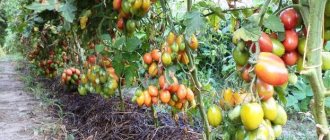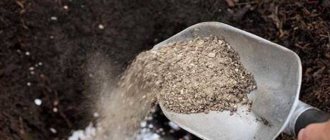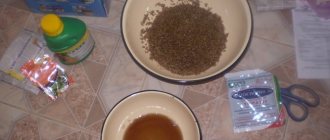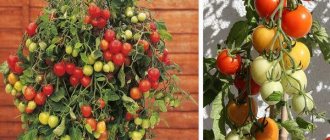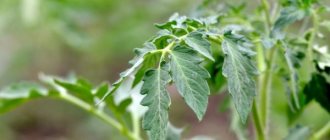Experienced gardeners know how to feed tomato seedlings on the windowsill. To know what trace elements are necessary for a high yield, it is necessary to observe the appearance of tomatoes. For normal growth, plants need a fertile soil containing trace elements.
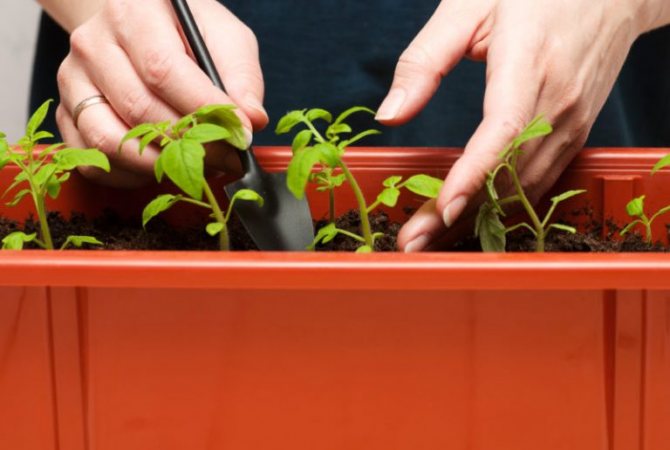
For normal growth, tomatoes need fertile soil containing trace elements. Illustration for this article is used under a standard license <885
How to determine when seedling feeding is necessary
Unlike wild plants, cultivars and hybrids obtained by breeding do not develop well in the absence of a sufficient amount of nitrogen, potassium and phosphorus. The first 2 elements are the basis of nutrition, and thanks to the latter, trace elements enter exactly those plant organs where they are needed.
By the following signs, you can determine whether you need to feed tomato seedlings:
| Missing item name | Manifestations |
| Nitrogen | Yellowing of the lower layer of leaves and a slowdown in growth rates if the rules for caring for seedlings are followed |
| Phosphorus | The appearance of veins with a purple tint on the back of the leaf plates |
| Potassium | Slowdown in seedling growth due to underdevelopment of the root system of seedlings |
| Iron | Withering and drying of tops, pale and yellow foliage, gradual death of roots |
| Calcium | Thin stem and gradual elongation of seedlings, color change |
An excess of nutrients, as well as their deficiency, can lead to a weakening of the seedlings' immunity. The foliage often turns yellow if the tomatoes are overfed with nitrogen-containing preparations.
Terms of feeding
To ensure the full development of seedlings, the seed should be sown in a fertile soil mixture. If the planting of seeds was carried out in compliance with all agrotechnical requirements, in the future it is necessary to adhere to the following terms of fertilizing:
- Development of the first leaves in seedlings.
- 2 weeks after the dive.
- Two weeks after the previous feeding.
- Three days before planting in garden beds.
In order to prevent an excess of any one element, it is recommended to use complex fertilizers for tomato seedlings.
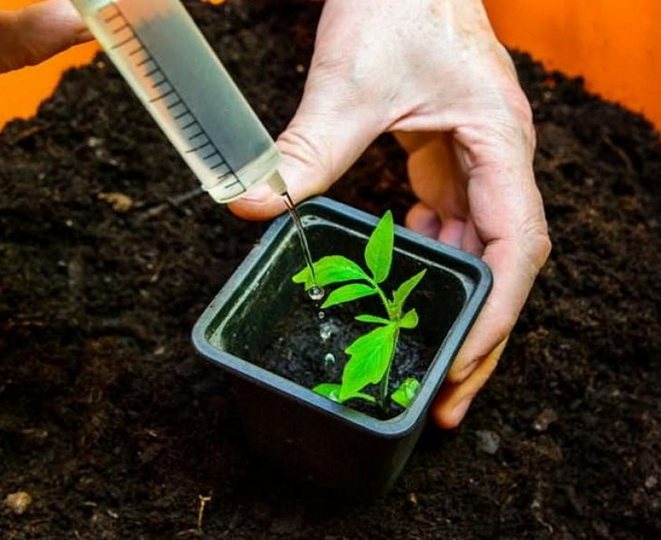

Common mistakes
In the desire to speed up the processes of growth and formation of seedlings, gardeners sometimes make mistakes that lead to the opposite result:
- overuse fertilizers using the wrong dosage;
- incorrectly determine what kind of fertilizer the crop needs;
- feeding at the wrong time or doing it in the wrong way.


If there is no experience in growing tomato seedlings, you should look for information on the rules for caring for it and adhere to it.
Features of feeding before and after a pick
The agrotechnology of growing tomato seedlings provides for a mandatory pick, in which the seedlings find themselves in a stressful situation. For a more painless transfer of the procedure, the plants should be fed 14-15 days before the manipulations. At this stage, the purpose of fertilization is to strengthen the immune system, so that the seedlings will not hurt for a long time after transplanting.
After the same period of time, in order to grow a healthy crop, it is recommended to carry out the next feeding. It will provide quick recovery of both vegetative and root mass in stunted seedlings.
Before feeding the seedlings to strengthen immunity and growth, you should make sure that the timing of feeding is met. Otherwise, such procedures can have the opposite effect - lead to the suppression of seedlings.
Useful Tips
Experienced vegetable growers advise:
- Excess nutrition can cause an increase in green mass and stem elongation. In this case, the seedlings must be transferred to a place with a lower temperature and lighting.
- Banana peels can be used as a top dressing - they are a good source of potassium. The infusion is made by pouring 3 liters of water into the peel of three bananas. After three days, the infusion is ready - you can water the seedlings.
- Top dressing will be much more effective if the soil is regularly loosened near the plants.
Growing tomato seedlings requires maximum attention from the gardener, it is important not only to feed on time, but also to correctly "diagnose". The coming harvest depends on the timeliness of dressings, the correctness of their choice and dosages.
Specificity of root and foliar feeding
To figure out how and how to properly feed tomato seedlings, you should study the stages of plant development and their need for nutrients.
- After emergence, sprouts most of all need nitrogen and phosphorus, which are rich in superphosphate and urea.
- With full growth before picking, feeding is repeated using the same agrochemicals. If the seedlings begin to stretch, then the nitrogen preparation is excluded.
- After transplanting, the seedlings need nitrogen to stimulate recovery. Therefore, it is better to use organic.
- When the laying of flower ovaries begins, potash dressings using nitroammofoska or potassium sulfate are most relevant.
How to feed at home after planting in the ground?
When preparing the seedling soil, it is easy to form a nutrient-rich substrate. Garden beds are a little more difficult to do the same. The optimal solution is to fertilize immediately after planting. The main thing is to always look closely at the plants and not overdo it.
In dry summers, potassium fertilizing will not only fail to bring the expected result, but can also cause plant diseases. If the summer is rainy, the seedlings may lack potassium in the soil, and then this element must be added when feeding.
This is done only 15 days after planting the plants in a new place so that they adapt to new conditions. After acclimatization, seedlings may require phosphorus-potassium fertilizers (PKU), which promote plant growth, budding, flowering and fruit formation. It is better not to carry out nitrogen-containing fertilizing.
Post Views: 2
What and how to feed tomato seedlings?
Gardeners and farmers, having come to a specialized point of sale of agrochemicals, are often lost. Among the wide assortment, it can be difficult to decide which fertilizer is best to feed tomato seedlings to ensure full growth and a good harvest.
How to fertilize tomato seedlings to increase the thickness of the stem?
If, in the case of a normal level of lighting on the window and an optimal temperature regime in the place of content, the foliage turns yellow, and the stem is thinned, this indicates an excess of nitrogen. It must be excluded from the top dressing and the plants should be sprayed with the "Athlete" preparation, and then fertilized with superphosphate. It is recommended to enrich the soil with a small amount of wood ash, which will prevent the tomatoes from pulling out.
In order for the seedlings to be plump, before feeding the tomato seedlings, she needs to ensure the appropriate length of daylight hours (10-12 hours), by lighting it up in the apartment or transferring it to the balcony.
How to fertilize tomato seedlings in the open field?
If an agrochemical contains nitrogen, phosphorus and potassium in its composition, then it can be attributed to the best fertilizers for both seedlings and adult plants. These 3 elements are present in equal proportions in nitroammophos, which is recommended to be brought under the planted specimens.
The mineral complex can be used as follows:
- 15 g of the preparation is thrown into each hole, after which it is thoroughly mixed with the soil.
- An aqueous solution is prepared from 50 g of nitroammofoska and 10 liters of water, used for watering at the root.
Liquid feeding is carried out a week after the plants are planted in the beds.
How to feed tomato seedlings in a greenhouse?
To minimize the stress received by the plants from the transplant, you should use folk remedies: before feeding the tomato seedlings, you need to prepare a green infusion at home. Chopped nettle greens are placed in the container, after which you need to add wood ash and mullein. The mixture is left for 2 days, and then it is diluted with water in a ratio of 1: 8. The application rate for each bush is 2 liters.
Mineral fertilizers
Top dressing of tomato seedlings is often carried out using complex agrochemicals. They contain important elements designed to strengthen the immunity of weak seedlings.
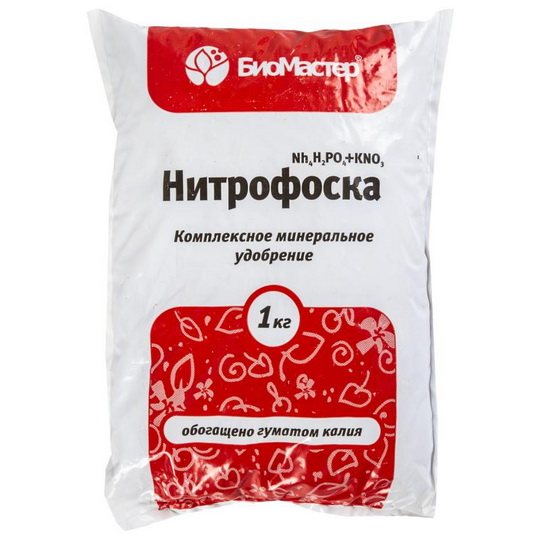

Nitrofoska
A common universal drug of the NPK group, which is distinguished by an acceptable price-quality ratio: for a low cost, it is possible to significantly increase the crop yield. It is good for them to fertilize seedlings a week after planting in open ground. The working fluid is prepared from 20 g of powder and 5 liters of water.
It is recommended to add the complex when planting.
Agricola
A very popular remedy, which contains 13% nitrogen and 20% potassium and phosphorus each, as well as a small content of trace elements: magnesium, zinc, copper and boron. For the growth of seedlings, the drug is applied by the foliar method 2 weeks after sowing the seeds. To prepare the working solution, use 25 g of the product and 10 liters of water. Subsequently, Agricola treatments are repeated several times with an interval of 15 days.
Effekton
There are several types of the drug on sale. For the cultivation of tomatoes, peppers and other vegetable crops, Effecton O is used, which repeats the composition of manure by 90%. Before use, 1.5 tbsp. l. agricultural means are diluted with 5 liters of water. The liquid is applied in any convenient way.
When using this biologically active fertilizer, all other dressings cannot be used.
Athlete
The water-soluble agent belongs to growth regulators and is effective in increasing the diameter of the stem in frail plants. It is used in 2 steps:
- In the phase of formation of cotyledon leaves as a liquid for irrigation, plants grow more slowly and do not stretch out due to lack of light, which is typical for early spring.
- For processing on shoots after picking.
Seed preparation
In order for the seeds of tomatoes and peppers to sprout well and begin their rapid growth, it is better to soak them in natural stimulants:
- Dissolve one teaspoon of any honey in 200 ml of room temperature water, then throw the seeds there for six hours.
- If aloe grows on your windowsill, then it can help the seeds germinate well. You need to cut one leaf off the aloe, wrap it in cheesecloth and put it in the refrigerator for 14 days. If time is short, then you can put it in the freezer for two days. After that, you need to squeeze out the juice well, dilute with water in equal proportions and soak the seeds in this solution for exactly one day.
- Peel the potatoes and put them in the freezer for three days.After that, the frozen potatoes must be passed through a meat grinder to get juice from it. The seeds are soaked in this juice for about 8 hours.
- The fastest way out of the above. You need to pour boiling water over the dry mushrooms, wait until the water cools down, then throw the seeds there for six hours.
Organic fertilizers
Organic matter should be used in the early stages of seedling development - while it is small, since it mostly contains nitrogen, which is necessary for the growth of green and root mass.
Compost
Fertilizer for seedling growth is used early in the growing season. It can be prepared from both manure and plants. In the first case, manure, peat, soil are mixed in a ratio of 5: 1: 1 and kept for about six months. In the second - fallen leaves, plant debris, soil and water. The product will be ready for use only after a year.
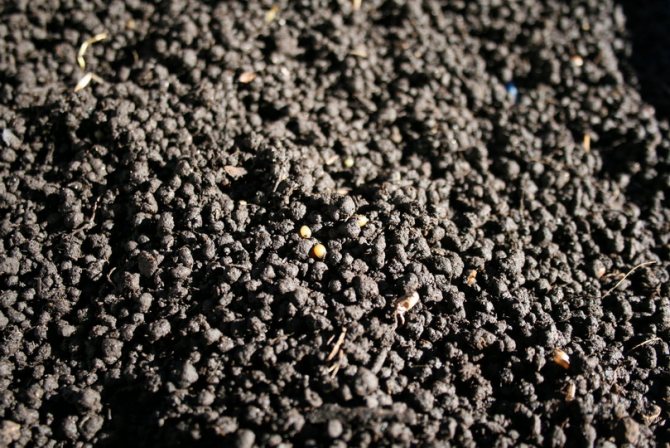

Biohumus
Gardeners who also grow indoor flowers know this remedy very well. It is used both for soaking seed and for forcing high-quality seedlings. The working solution is prepared from water and the drug in a ratio of 1:20. Consumption rate - 1-2 liters per 1 m2.
Folk remedies
At home, you can easily prepare fertilizer for seedlings, which will show excellent results.
Yeast
An affordable food supplement often becomes the basis of a nutritional formula, which is prepared from 10 g of a briquette and a bucket of water. The working solution should be applied immediately after infusion, which is carried out during the day. Storage not recommended.
Ash
For feeding, an extract based on this substance is used. It is very simple to prepare it: just mix 2 liters of heated water and 30 g of the product. After the mixture is infused for about a day, the liquid is filtered. It can be used both to water the ground and to spray the crop on the leaves.
Eggshell
The nutrient composition can be prepared from egg waste. For this, the shell is ground and infused in water. Application is possible after the beginning of fermentation, which is indicated by the appearance of an unpleasant odor.
Onion husks
The waste of a widely used vegetable can be used for feeding due to its high nutrient content:
- carotene;
- phytoncides;
- vitamins of groups B and PP.
When forcing tomato planting material, it is recommended to fertilize crops with infusion.
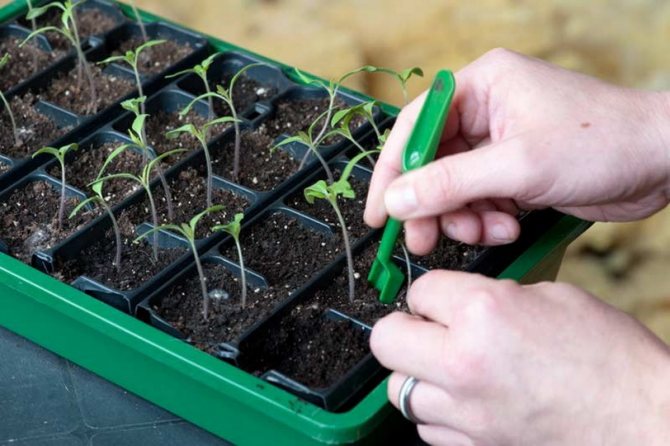

Main components:
- 2 cups husk
- 2 liters of boiled water.
Method of preparation: plant residues are poured with boiling water, after which the product is infused for 2 days.
When watering or spraying seedlings, take 3 parts of pure water and 1 part of a concentrated infusion.
Milk
Milk mixture is used as a disinfectant for seedlings. You can prepare it from:
- glasses of milk:
- 5 drops of iodine;
- 1 liter of water.
Hydrogen peroxide
If there is no desire to resort to chemistry, then growth can be stimulated using a peroxide solution prepared from 1 tbsp. l. means and 1 liter of warm water. The mixture is used for spraying. To understand how many procedures will be required, it is necessary to constantly monitor the condition of the seedlings. If the stems are thick and the foliage is large, then once every 10 days is enough.
Peroxide disinfects well the soil for sowing seeds with which the boxes are filled. In peat pots, the substrate has already been processed and does not need additional procedures.
The working solution can be used for watering under the plant to combat root rot, but then the small roots die.
Potassium permanganate
If the foliage is small, then feeding with a light solution of manganese (weak concentration) will contribute to the acceleration of the growth of shoots. It also protects seedlings from infection with various ailments.

